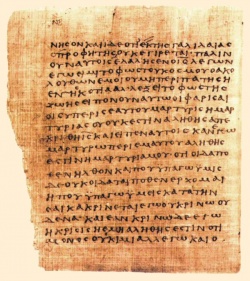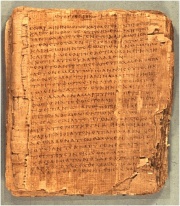Papyrus 66
From Textus Receptus
| Line 11: | Line 11: | ||
== Text == | == Text == | ||
| - | + | [[Image:Papyrus 66 (GA).jpg|thumb|Staurogram in the third, sixth, and tenth line]] | |
| - | The Greek text of this codex is a representative of the [[Alexandrian text-type]]. Aland ascribed it as "Free text" and placed it in I Category.< | + | The Greek text of this codex is a representative of the [[Alexandrian text-type]]. Aland ascribed it as "Free text" and placed it in I Category.<sup>[]</sup> |
A transcription of every single page of [[Image:C3945eee4633c095c5059f9a67aca5f7.png]]<sup>66</sup> is contained in the book referenced in reference 2, pages 388-468. | A transcription of every single page of [[Image:C3945eee4633c095c5059f9a67aca5f7.png]]<sup>66</sup> is contained in the book referenced in reference 2, pages 388-468. | ||
Revision as of 04:33, 23 November 2012
Papyrus 66 (also referred to as ![]() 66) is a near complete codex of the Gospel of John, and part of the collection known as the Bodmer Papyri.
66) is a near complete codex of the Gospel of John, and part of the collection known as the Bodmer Papyri.
Contents |
Description
The manuscript contains John 1:1-6:11, 6:35b-14:26, 29-30; 15:2-26; 16:2-4, 6-7; 16:10-20:20, 22-23; 20:25-21:9, 12, 17. It is one of the oldest New Testament manuscripts known to exist, with its writing dated to around 200 BC.[]
In common with both the other surviving early papyri of John's Gospel; P45 (apparently), P75, and most New Testament uncials, Papyrus 66 does not include the pericope of the adulteress (John 7:53-8:11)[]; demonstrating the absence of this passage in all the surviving early witnesses of the Gospel of John. The manuscript also contains, consistently, the use of Nomina Sacra.
According to recent studies done by papyrologists Karyn Berner[] and Philip Comfort,[] it is evident that ![]() 66 had the work of three individuals on it: The original, professional scribe, a thoroughgoing corrector and a minor corrector.
66 had the work of three individuals on it: The original, professional scribe, a thoroughgoing corrector and a minor corrector.
Text
The Greek text of this codex is a representative of the Alexandrian text-type. Aland ascribed it as "Free text" and placed it in I Category.[]
A transcription of every single page of ![]() 66 is contained in the book referenced in reference 2, pages 388-468.
66 is contained in the book referenced in reference 2, pages 388-468.
In John 13:5 it has unique textual variant ποδονιπτηρα instead of νιπτηρα. In 13:7 it has αρ (error) instead of αρτι.
History
The manuscript was found in 1952 at Pabau near Dishna (Egypt).
It is currently housed at the Cologny-Geneva, Switzerland: Bibliotheca Bodmerians. The Papyrus contains 39 folios (that's 78 leaves, 156 pages), at a size of 14.2 cm x 16.2 cm for each leaf with roughly 15-25 lines per page.
See also
References
External links
- Papyrus 66 at Bible Research


